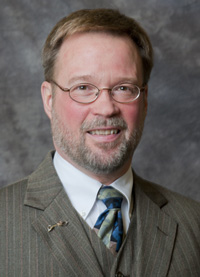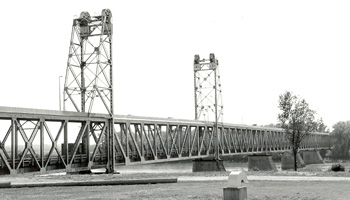Jay D. Vogt, South Dakota State Historic Preservation Officer, NCSHPO President, 2005-2009
What led you to your field?
I always thought I would work in politics. However, after eight years of working in a political office, I discovered that, although I enjoyed the work, it was not the most stable employment. My wife, Elizabeth, and I had three boys by then, so a steady job was important. I ended up joining the staff of the State Historical Society as the “executive assistant.” I always enjoyed history, but my job was more on the administrative side of the business. My college education had prepared me to be a teacher, so I was interested in developing an education program for the Society. After another eight years, the former governor returned to office and implemented a reorganization of state government. Coincidentally, the Society director accepted another position out of state, and within a year, the director of historic preservation also left. My new director returned from a meeting on the reorganization and informed me that I was going to be the new State Historic Preservation Officer.
Historic preservation was never on my career radar screen, so being asked to head the state historic preservation office was “fool’s luck.” Unfortunately, the historic preservation office was located in another community, and I was tasked with moving it to the state capital. My selection was controversial, and relocating the office was unpopular, but I was determined to succeed. With the assistance from friends at the National Conference of State Historic Preservation Officers, the National Park Service, and the National Trust for Historic Preservation, Denver Office, I learned a lot quickly and toughed it out. Now I say I had “dumb luck” being appointed the State Historic Preservation Officer, and it has been a rewarding experience.
How does what you do relate to historic preservation?
Since I did not come to the historic preservation field in the traditional way, as the State Historic Preservation Officer I approach our work differently. My father was a pharmacist and owned a drug store, where I “helped out” quite a bit. It was that experience that instilled in me a strong sense of providing “customer service.” Consequently, it is my opinion that the state historic preservation office does not do historic preservation; rather we make it possible for businesses and individuals to preserve, rehabilitate, or restore historic properties. Who are our customers and how do we serve them best? When it comes to Section 106 of the National Historic Preservation Act, we help federal agencies comply with the law. We are advocates for historic properties, but we also collaborate with federal agencies. By working with the federal agencies, we gather better information that generally results in improved identification and preservation and/or achieve “value-added” mitigation of adverse effects.
Why do you think historic preservation matters?
Often times when we think about history, we think of people…who they are and what they accomplished. But because human life is short, a large part of what we understand about the past comes from what people made and left behind, such as written records, objects, buildings, and structures…houses from the modest to the grandiose, commercial blocks, public works of art, bridges, fountains, monuments, and so forth. These physical remnants allow us to verify the past by seeing and touching the creations of people who came before us. We can connect with and learn from our history. People from rural communities to large metropolitan cities can walk down a street, point to a particular house or a commercial or public building, and recognize that those structures are more than just bricks and mortar—they are icons of our past.
What courses do you recommend for students interested in this field?
From a State Historic Preservation Office perspective, preparing to work in the historic preservation field, individuals need an appreciation for and an excellent grounding in history. Archaeological sites, buildings, cultural locations, homes, and structures are the places of history. Their significance is their importance.
Further, the ability to communicate is essential, so good public speaking talents and top-notch writing skills are indispensable. Often times we are the only advocate for historic properties, and we need to be able to articulate our case or cause and convince without alienating and without hysteria. English courses, both writing and speaking, are a must. My wife is an English teacher, what can I say?
As a graduate of Augustana College in Sioux Falls, South Dakota, I am definitely prejudiced toward a liberal arts education. However, I would be disingenuous if I did not admit that the historic preservation field is also “technical.” In addition to a well-rounded education, people who want to thrive in the historic preservation field need to focus their strengths in anthropology and archaeology, architecture, and/or building and craftsman skills.
Do you have a favorite preservation project? What about it made it special?
My favorite preservation project is saving the Meridian Bridge. The double decker, vertical lift bridge crosses the Missouri River into Nebraska at Yankton, South Dakota. When the bridge was completed in 1924, it was the last connection of the Meridian Highway (U.S. Highway 81) between Mexico and Canada. My Vogt grandparents lived in Yankton, and as a child, when I would stay with them, one of our favorite excursions was driving over the Meridian Bridge. The bridge soars above the Missouri River, and from the top deck, it is a magnificent view down the river.

When I became the State Historic Preservation Officer in 1996, the Meridian Bridge was threatened with demolition because it was being replaced by a new vehicular bridge at Yankton. Fortunately, my new best friend and Nebraska Deputy State Historic Preservation Officer Bob Puschendorf took the lead and advised me on the workings of Section 106, and together we persevered and convinced the Federal Highway Administration, our states’ departments of transportation/roads, and the city of Yankton to convert the bridge to a pedestrian crossing. This summer, for only the second time, I walked across over to Nebraska on the lower deck and back to South Dakota on the upper deck along with many, many other people. It is now a popular part of the Yankton trail system.
Can you tell me what you are working on right now?
Elizabeth and I raised our three boys in a small 1920s Bungalow home. The previous owners had done a little re-muddling, and we are at the point that we would like to rehabilitate the house and bring back some of its lost features. We have worked with architect Brad Ciavarella of Mitchell, South Dakota, to develop appropriate plans to update our house and re-install a front porch.
How do you think the national historic preservation programs help your community?
A common phrase in American politics and coined by former Speaker of the U.S. House of Representatives Tip O’Neill is “all politics is local.” The same is true for historic preservation. Many communities have a strong preservation ethic. I believe most people appreciate history and historic preservation until something “old” gets in the way of their project or goals. Nevertheless, local pride in their history and historic icons can have a significant impact on a community. For example in South Dakota, the Meridian Bridge is an important symbol of the city of Yankton, the World’s Only Corn Palace is the same for the city of Mitchell, the State Capitol for the city of Pierre, Dinosaur Hill for the city of Rapid City, the Campanile for the city of Brookings, and of course, Mount Rushmore National Memorial for the state of South Dakota. All these icons are listed in the National Register of Historic Places.
However, it is the national historic preservation program that draws attention to historic properties and grassroots efforts through the National Register of Historic Places and rehabilitation projects, as well as community activities and public education hosted by historic preservation commissions in certified local governments. Federal and state agencies pause to consider impacts to historic properties. Prior to a national program, historic properties, such as archaeological and cultural sites, buildings, homes, and structures did not have a voice. Today, State Historic Preservation Officers, federal agencies such as the Advisory Council on Historic Preservation and the National Park Service, American Indian Tribes, and local historic preservation commissions can advocate on behalf of historic properties with authority.
The ACHP’s mission is “preserving America’s heritage;” can you give us an example of how your community is preserving their heritage?
A local preservation success story in a community can make a big difference. For example, 25 years ago, the state of South Dakota restored most of the public spaces in the State Capitol, and from that point forward, the care and preservation of the building became a top priority. Not only do state government and the local community take great pride in the State Capitol, so do citizens throughout the state. For the state of South Dakota’s 125th anniversary in 2014, all the historic stained glass—four major installations—in the State Capitol are being restored prior to the November 2 anniversary date. This project is just starting, and the State’s Bureau of Administration is already posting photographs of the progress.
Read more Q&A stories about the preservationists in your neighborhood!